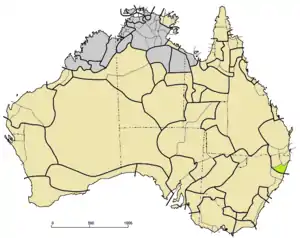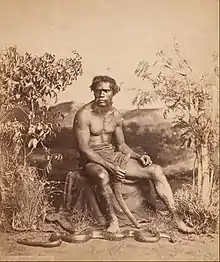Gumbaynggirr
Gumbaynggir (also "Kumbainggar", as pronounced by the first European settlers) are an Australian Aboriginal group on the Mid North Coast of New South Wales. The Gumbaynggirr Nation is from Tabbimoble Yamba- Clarence River to Ngambaa-Stuarts Point, SWR- Macleay. The Gumbaynggirr have the largest midden-shell deposit in the Southern Hemisphere.
Language

Gumbaynggir is classified as one of the two Gumbaynggiric languages of the Pama–Nyungan family. In 1986 the Muurrbay Aboriginal Language and Culture Co-operative was established by Gumbaynggirr elders to revive their language and hand it on.[1] Language classes began in 1997, and by 2010 some several hundred people had some partial grasp of the language.[2]
Culture
Muurrbay in Gumbaynggir means the white fig tree and plays an important part in the Gumbaynggir Yuludarla (Gumbaynggir Dreamings).[3]
The Gumbaynggirr made sweets (bush lollies, called jaaning)[lower-alpha 1] by rolling tender shoots from the Acacia irrorata in the sap oozing from the tree.[4]
Country
The Gumbaynggirr lands extend over an estimated 2,300 square miles (6,000 km2)[5] covering an area of the Mid North Coast from the Nambucca River to as far north as the Clarence River (Grafton), and eastward to the Pacific coast. Norman Tindale specified its limits as bounded by the lower course of Nymboida River, stating that the territory ran toward Urunga, Coffs Harbour, and Bellingen. It included South Grafton and Glenreagh. It took in the coastal strip south from near One Tree Point, Woolgoolga and Nambucca Heads.[5] The thin coastal zone from Coffs Harbour to Evans Head was Yaygir territory.[6]
To their north were the twenty groups speaking various dialects of the Bandjalang. The Jukambal were to their west and the Nganyaywana/Anēwan in the environs of (Armidale). Their southern boundaries met with those of the Djangadi and Ngamba.[6]
History

Clement Hodgkinson was the first European to make contact with the local Aboriginal community when he explored the upper reaches of the Nambucca and Bellinger Rivers in March 1841. Three decades later, loggers began to work their way up through the Orara River cedar stands in the 1870s. Over c.1873-1874 J.W. Lindt produced photographs of local indigenous people both in their environment and conducting actual traditional ceremonies in the Clarence River district,[7][8] and made portraits in his studio.[9] Contemporary commentary records them as "the first successful attempt at representing the native blacks truthfully as well as artistically."[10] The Sydney Morning Herald, of 24 November 1874 expanded on what made the photographs attractive to Europeans;
There is no settled portion of our colony which affords a better field for the study of aboriginal bush life than that presented by our northern rivers, for there - although decreasing yearly in numbers as their territories become more settled upon by white population - the local original inhabitants preserve their customs and traditions, adhering more closely to true aboriginal life than tribes in other districts of New South Wales, and Mr Lindt can be complimented upon the artistic use he has made of the rugged subjects he has had at his disposal.[11]
The report clearly sets out a cynical nostalgia for the traditional ways of these people made sentimental by noting their 'decreasing numbers', expressing a common attitude amongst the colonists that the indigenous populations were doomed.[12] However, the individuals in Lindt's group portraits and their clans and languages (Gumbaynggirr and Bandjalung),[12] are not named, the 'scenery' is generic, and the accessories not those of the people depicted.[13][14]
In clearing the land, the loggers opened up the prospect of selectors to squat on the tribal territories in the early 1880s.[15][16] Soon after, in that same decade, a shepherd was murdered in the area and a hunting party was dispatched to exact revenge, resulting in the Red Rock Massacre.[17] The slaughter started at Blackadder Creek where the Gumbaynggirr were camping. Mounted troopers entered the camp and began shooting. Those who fled were tracked down to the Corindi Creek where more were shot. Those who survived were driven to the headland and herded off the rocks into the sea. The hunters kept shooting at the swimmers, but some hid in a cave and made their way to Corindi Lake further south.[18][19] One of the survivors was the present day elder Tony Perkins' grandmother, who crouched down in a thicket of bulrushes with a child in her arms.[18]
After a court battle lasting two decades, the Gumbaynggirr claim to much of the reserve around the site in 2014 was confirmed by the New South Wales Land and Environment Court.[20]
Many reserves and missions was established in NSW by the Aboriginal protection board this resulted in relocation of aboriginals from their once called ancestry homes to only to be returned to home location after years of trauma, the land they stood on was altered for Whitemans usage later on.
Current population
Today current Gumbaynggirr population in the area of this tribe is about 18,000.
The Gumbaynggir are an active people who recently represented themselves at the "New Way" Sovereignty Summit Canberra Conference convened by 1972 Aboriginal Tent Embassy. Four last living Leaders and Gamilaraay elected Sovereign Spokesman Michael Anderson.[21]
Some words
Alternative names
- Bellinger; Balinjin Tribe
Traditional Custodians; Dialect
- Yurruunn.Ga ~ Urunga
Meaning; Hightide sacred place
- Coombagoree, Gumbanggar
- Coombangree, Coombyngura, Coombyngara, Coombargaree, Kombinegherry
- Gumbainggar, Gunbainggar, Gumbaingar, Guinbainggiri
- Kombaingheri, Kombinegherry, Kumbangerai, Koombanggary, Koombanggherry, Koombainga
- Nimboy (a horde)
- Orara (name of a river)
- Woolgoolga (a horde)
Source: Tindale 1974
Notable Gumbaynggirr people
- Aretha Brown, youth activist
- Troy Cassar-Daley, an Aboriginal country music singer-songwriter from Halfway Creek/Grafton NSW. Born 1969.
- Emma Donovan, an Aboriginal singer and songwriter (Gumbaynggirr heritage from mother's side)
- Gary Foley, a Gumbaynggirr activist, academic, writer and actor
- Greg Inglis, an Aboriginal, rugby league player
- Albert Kelly, an Aboriginal, rugby league player
- Loretta Kelly, an Aboriginal law academic
- Mr Richard Kelly SNR, a Traditional Custodian/ Elder & Forestry Heritage Officer.
- Aden Ridgeway, a former Australian Senator who served from 1999 to 2005
Notes
- the word is said by Gumbaynggir restaurateur Clayton Donovan to be pronounced jasrnee
Citations
- Muurrbay 2017.
- Hobson 2010, p. 107.
- Somerville & Perkins 2010, p. 159.
- Newton 2016, p. 212.
- Tindale 1974.
- Eades 1979, p. 249.
- Annear et al. 1997.
- Grafton Regional Gallery.
- Ennis 2007.
- Australian Town and Country Journal 5 December 1874, p.21
- Sydney Morning Herald, 24 November 1874, p.5
- Baymarrwan̦a, James & Lydon 2014.
- Hughes-d'Aeth 2001.
- Konishi 2015.
- Lunney, Wells & Miller 2016, p. 1.
- Prentis 2011, p. 100.
- Somerville & Perkins 2010, pp. 24–32.
- Somerville & Hartley 2013, p. 145.
- Stone 2012, p. 14.
- Grewal 2014.
- Aboriginal Summit.
- Poole & Williams 2011.
Sources
- "13/01/10: Call to an Aboriginal Summit in Australia". WGAR: Working Group for Aboriginal Rights (Australia). 13 January 2010. Archived from the original on 11 April 2010. Retrieved 18 April 2015.
- Annear, Judy; Donohue, Robyn; Tunnicliffe, Wayne; Velez, Silvia (1997). Portraits of Oceania. The Art Gallery of New South Wales. ISBN 978-0-7313-1003-6.CS1 maint: ref=harv (link)
- Baymarrwan̦a, Laurie; James, Bentley; Lydon, Jane (2014). Calling the shots: aboriginal photographies. Aboriginal Studies Press. ISBN 978-1-922059-59-8.CS1 maint: ref=harv (link)
- "The Clarence Valley Photographs by John William Lindt: : Grafton Regional Gallery". Grafton Regional Gallery. Retrieved 1 March 2020.
- Eades, Diana (1979). "Gumbaynggir". In Dixon, Robert M. W.; Blake, Barry J. (eds.). Handbook of Australian Languages. Volume 1. John Benjamins Publishing. pp. 243–360. ISBN 978-9-027-20512-4.CS1 maint: ref=harv (link)
- Ennis, Helen (2007). Photography and Australia. Reaktion Books. ISBN 978-1-86189-323-9.CS1 maint: ref=harv (link)
- Grewal, Jessica (1 February 2014). "Aboriginal Land Council wins claim on Red Rock reserve". The Daily Examiner.CS1 maint: ref=harv (link)
- Hobson, John Robert (2010). Re-awakening Languages: Theory and Practice in the Revitalisation of Australia's Indigenous Languages. Sydney University Press. ISBN 978-1-920-89955-4.CS1 maint: ref=harv (link)
- Hughes-d'Aeth, Tony (2001). Paper nation: the story of the Picturesque atlas of Australasia 1886 - 1888. Melbourne University Press. ISBN 978-0-522-84949-3.CS1 maint: ref=harv (link)
- Kijas, Johanna (June 2009). There were always people here: a history of Yuraygir National Park (PDF). Department of Environment and Climate Change, New South Wales. ISBN 978-1-741-22866-3.CS1 maint: ref=harv (link)
- Konishi, Shino (2015). Konishi, Shino; Nugent, Maria; Shellam, Tiffany Sophie Bryden (eds.). Indigenous intermediaries: new perspectives on exploration archives. ANU Press. ISBN 978-1-925022-76-6.CS1 maint: ref=harv (link)
- Lunney, Daniel; Wells, Antares; Miller, Indrie (2016). "An ecological history of the Koala Phascolarctos cinereus in Coffs Harbour and its environs, on the mid-north coast of New South Wales, c.1861-2000". Proceedings of the Linnean Society of New South Wales: 1–48.CS1 maint: ref=harv (link)
- "Muurrbay". Muurrbay Aboriginal Language and Culture Co-operative. 2016.
- Newton, John (2016). The Oldest Foods on Earth: A History of Australian Native Foods with Recipes. NewSouth. ISBN 978-1-742-24226-2.CS1 maint: ref=harv (link)
- Poole, Fiona; Williams, Gary (7 November 2011). "Gumbaynggirr language". ABC News.CS1 maint: ref=harv (link)
- Prentis, Malcolm David (2011). Concise Companion to Aboriginal History. Rosenberg. ISBN 978-1-921-71961-5.CS1 maint: ref=harv (link)
- Somerville, Margaret; Hartley, Laura (2013). "A Space In-between: Red Rock". Journal of the Association for the Study of Australian Literature: 142–148.CS1 maint: ref=harv (link)
- Somerville, Margaret; Perkins, Tony (2010). Singing the Coast. Aboriginal Studies Press. ISBN 978-0-855-75711-3.CS1 maint: ref=harv (link)
- Stone, Derrick (2012). Walks, Tracks and Trails of New South Wales. Csiro Publishing. ISBN 978-0-643-10692-5.CS1 maint: ref=harv (link)
- Tindale, Norman Barnett (1974). "Kumbainggiri (NSW)". Aboriginal Tribes of Australia: Their Terrain, Environmental Controls, Distribution, Limits, and Proper Names. Australian National University Press. ISBN 978-0-708-10741-6.CS1 maint: ref=harv (link)